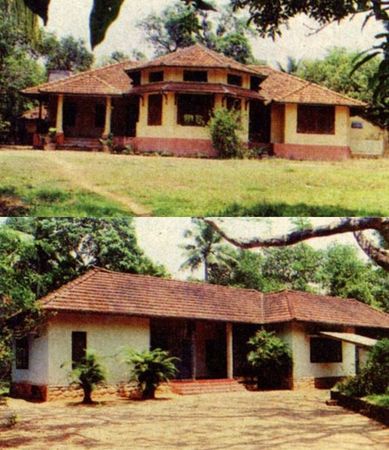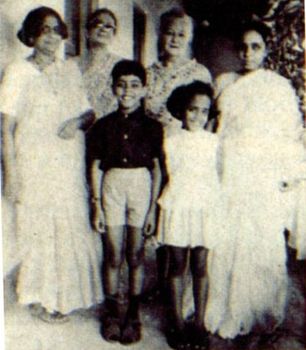 Puliyampallil House (top) and Shanti House in Aymanam on which Arundhati has modelled 'Ayemenem House'
Puliyampallil House (top) and Shanti House in Aymanam on which Arundhati has modelled 'Ayemenem House'
A few kilometres from Kottayam town in central Kerala lies Aymanam village, which forms a part of Arundhati Roy's 'Ayemenem country' in The God of Small Things. Those embarking on a literary pilgrimage, however, will not find any 'Ayemenem House' here.
But the house is not entirely fictional. An architect by training, Arundhati has borrowed brick and timber from two old buildings in the village—Puliyampallil House and Shanti House—to construct her 'Ayemenem House'.
The two houses stand on adjacent plots at the end of a rubber tree-fringed path from the Rev. Rao Bahadur John Kuriyan School at Aymanam junction. One of the real-life landmarks in the novel, the school was founded by Arundhati's great-grandfather John Kuriyan, a chief engineer turned priest.
Puliyampallil is an elegant, early 20th century building "with its steep gabled roof pulled over its ears like a low hat". Arundhati's mother Mary Roy and uncle George Issac, on whom she modelled the character 'Chacko', concede that it resembles the 'Ayemenem House'.
With a sloping, circular foreground, it has the folding doors and side entrances that 'Mamachi' built for the use of her son Chacko and his men. Mamachi is the grandmother of Rahel, the narrator. Today, the house belongs to one of Arundhati's aunts, who lives abroad.
The adjacent Shanti House has more European interiors. Designed in the early sixties by Issac's divorced first wife Cecilia Philipson ('Margaret' in the novel), it now belongs to Mary Roy's aunt, Dr Mary Eapen who, of course, has nothing to do with the fictional 'Baby Kochamma'.
 Arundhati and brother Lalit at Aymanam with Mary Roy (extreme right) and others
Arundhati and brother Lalit at Aymanam with Mary Roy (extreme right) and others
There is no 'Paradise Pickles' factory at either house; the Palat Pickles that Issac started after his higher education in England is located near his ancestral house Palathinkal at the local bus-stand. It bears the same slogan as the novel's pickle factory: "Emperor in the realm of taste." Issac lives with his mother, still cherishing his English interlude and often sporting the coat of arms of his college.
Across the fields behind Puliyampallil, the river Meenachil flows. The 'History House of Kari Saippu' where 'the terrible tragedy' took place is supposed to be on the other side of the river. In reality the house of 'Kari Saippu' is 14km away at the Kumarakom bird sanctuary.
In 1877, the Protestant missionary George Baker built a double-storey thatched house at Kumarakom. It became home to four generations of the Bakers who were called 'Kari Saippu' after the fertile kari lands on which they lived. In 1977, the Bakers disposed of the house, which is now the pride of Taj Garden Retreat. The building bears no resemblance to the History House, and no one remembers anyone from the Baker clan cadging cigarettes or any story about the ghosts of the Bakers.
Little Arundhati and her brother Lalit (no twins) may often have played on river banks, but there was no 'Sophie Mol'—Chacko's daughter who drowns in the river. Like the drowning, almost every tragic event in the novel is fictional.
Aymanam is no longer the old-fashioned village of the sixties in which the novel is set. It is now a bustling extension of Kottayam town, with 7,000 houses and a rash of dish antennae. Social prejudices have dissolved to great extent, though an affair between a low caste man and an upper caste woman can still cause quite a flutter.
(Reproduced from issue dated October 26, 1997)






